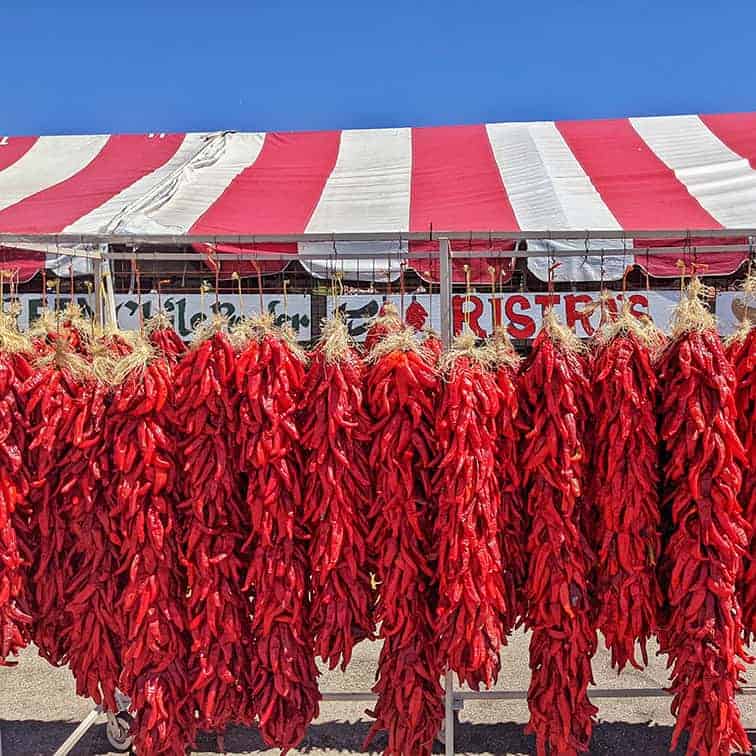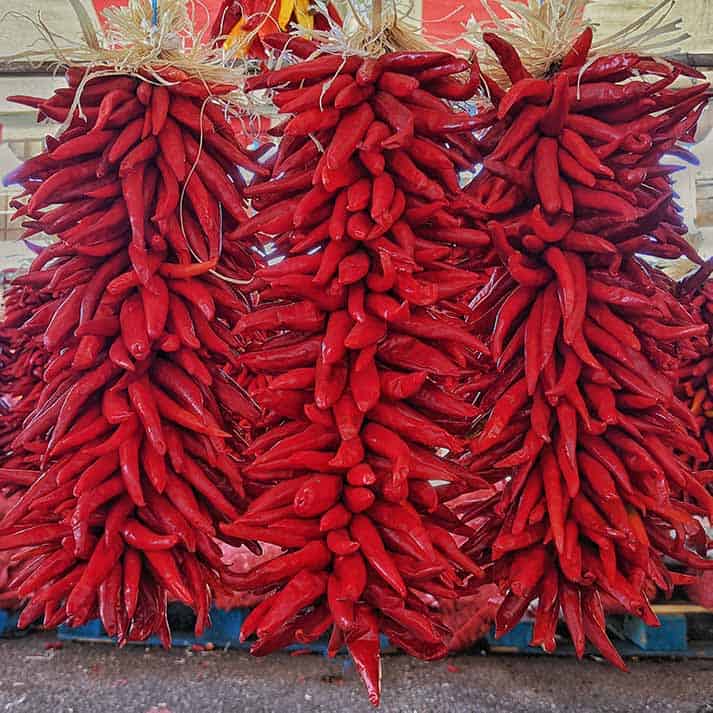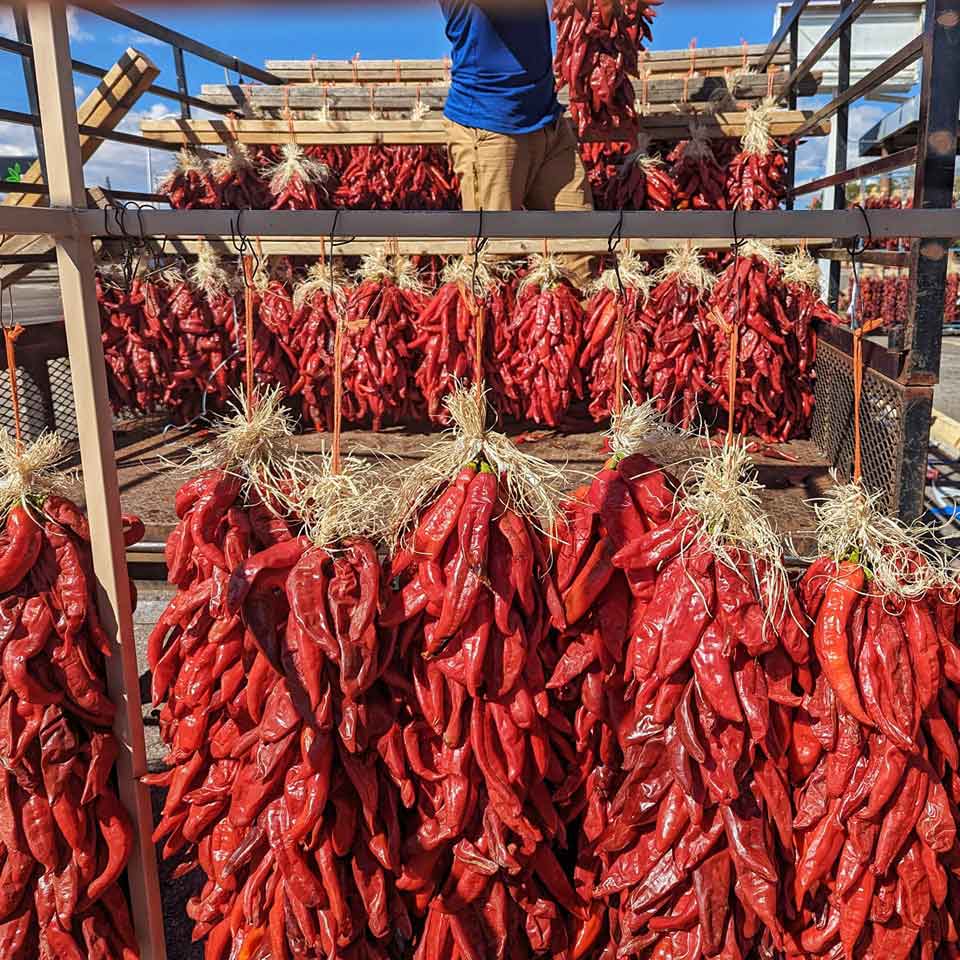Your cart is currently empty!
All About Chile Ristras
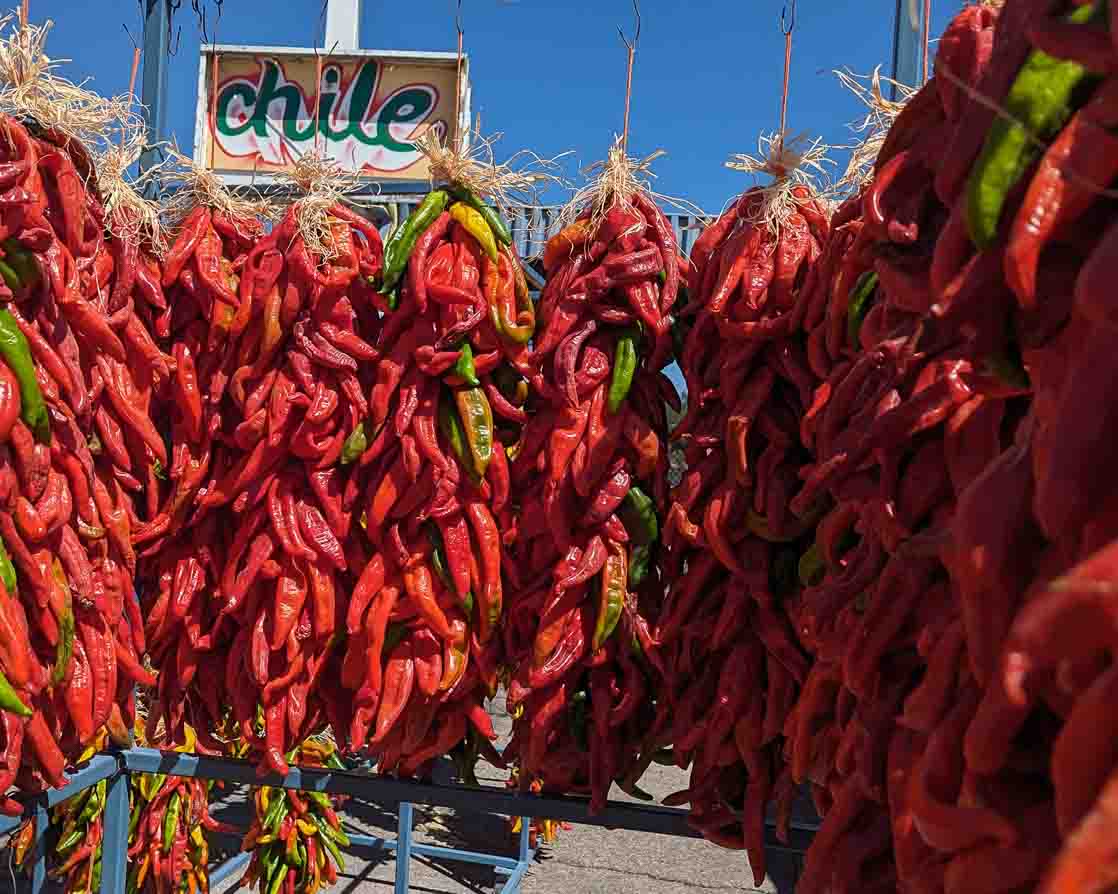
Chile ristras are a beautiful decoration, certainly, but they are above all else a means of safely drying chile. Birds love seeds, as evidence by the word “birdseed.” More than just that, they are immune to capsaicin, the chemical which gives chile its spice. Because of this, the need to hang chile in order to preserve it emerged, and with it the chile ristra. For those looking to shop online, jump down to buy a ristra! If you are in Albuquerque, come shop at our chile stand at 2010 Eubank Blvd NE during the chile season.
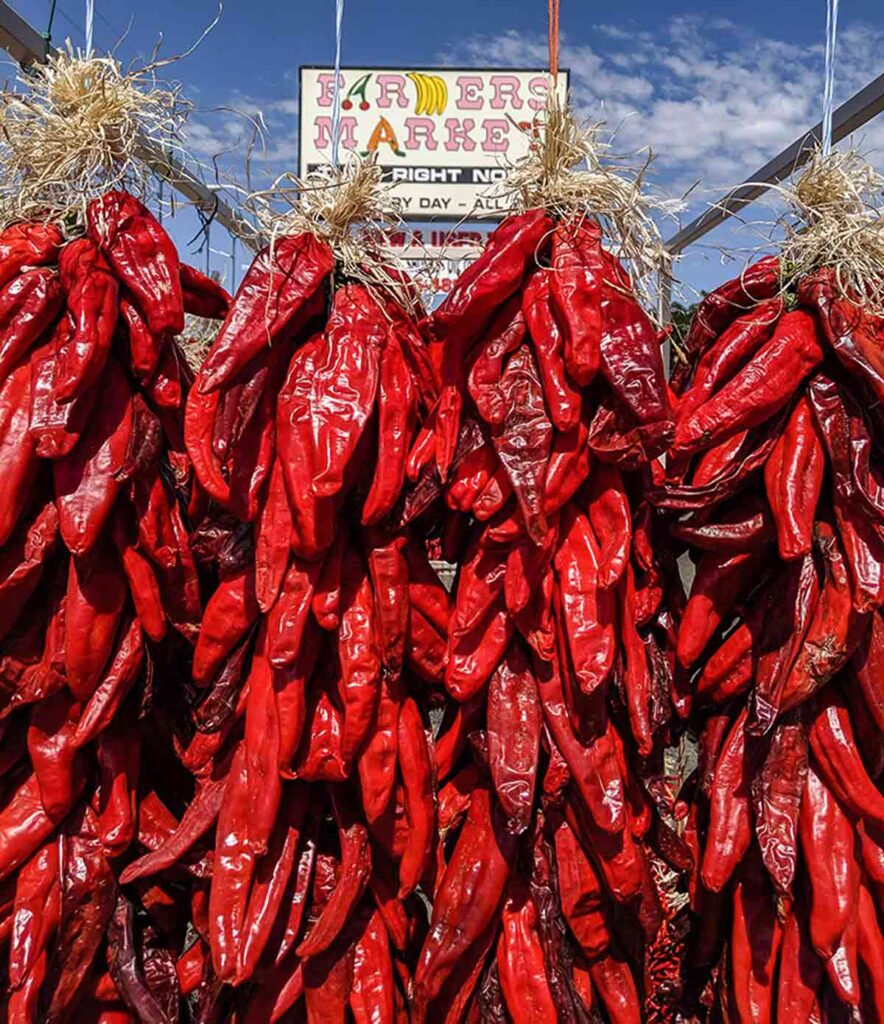
Chile Ristras in New Mexico
Ristras come in all shapes and sizes. Generally, they are made with fresh New Mexico red chile primarily grown in the Hatch Valley. At Farmers Chile Market, the ristras we sell come exclusively out of Hatch, as their level of chile production is much higher than other areas of New Mexico. The traditional straight ristras are the most common, but you can find ristras in the shape of wreaths, hearts, crosses, and even squares and triangles. There are many different types of chile used other than Hatch chile, such as pequin.
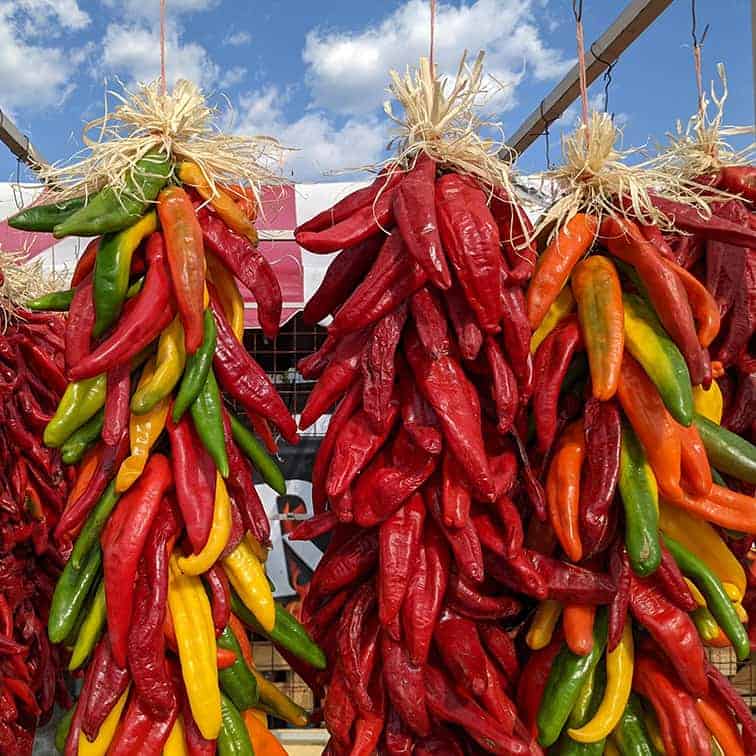
What is a ristra?
In Spanish, the word “Ristra” means string. You can find many different ristra varieties, such as using chile, garlic, or other things. Ristras are a way to dry and preserve chile, and have been made for a very long time. In New Mexico, because chile ristras are so prevalent, many people simply just use the word ristra to mean chile ristra. In short, a ristra is dried or drying red chile peppers on a string. As it it essentially just tying or sewing chile onto a string, they are quite easy to make. Jump down to our guide to make a ristra if you want to learn how!
For some people, they consider chile ristras to be a great welcoming decoration next to their front door. For others, a ristra belongs best in the kitchen, where they can conveniently cook with the dried chile. It’s a personal choice for anyone, and the drive or flight home from New Mexico is a great chance to ponder what place works best for you!
Ristras are great decorations
A ristra is a great way to spice up a room, both figuratively and literally. They are super common to see all over New Mexico, and other nearby states such as Arizona, Colorado, or Texas as well! The dull red color of a dry chile ristra goes wonderfully with the adobe buildings common in New Mexico! A ristra on the front porch brings a friendly New Mexican feeling of hospitality. I estimate that at least half of the ristras people buy from us are used purely as a decoration, so don’t feel odd if you use a ristra as just a Southwestern accent piece!
Ristras are especially good for New Mexican Restaurants
Every year, there are many local restaurants in Albuquerque, Rio Rancho, Corrales, Santa Fe, and everywhere else in New Mexico who purchase ristras to use for decorations in front of their eateries! What better way of showing of New Mexican cuisine than a decoration made entirely of New Mexican food!
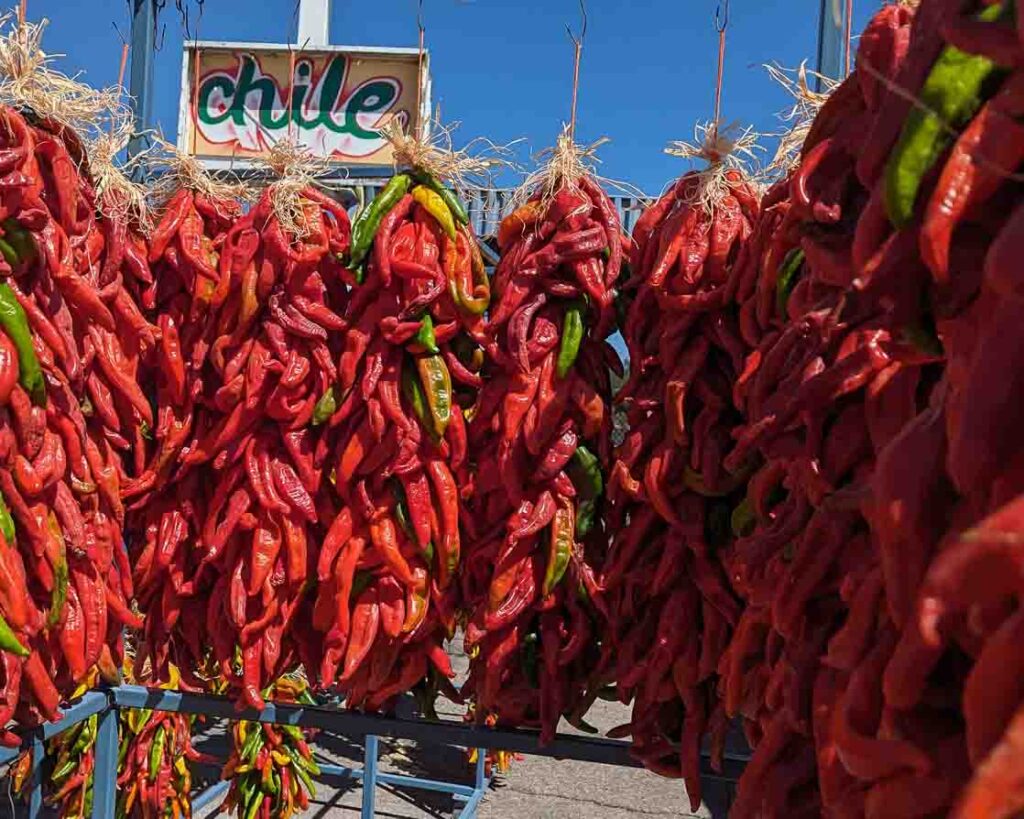
Ristras are great gifts
Ristras make an ideal southwestern gift for any occasion. Whether you have a loved one’s birthday, a wedding, or some other occasion, a ristra is a great idea to give a splash of Southwestern style to someone. Buying a ristra for someone is a great way to wish them good luck and good health, wherever they may be!
Ristras are delicious
Dried red chile pods have a very complex flavor. This is because the natural drying process causes the chile to age naturally, with a fermentation process which turns sugars in the red chile into more complex flavor compounds. Ask anyone who has tried, and they will tell you that fresh red chile is very sweet. This is because red chile is the ripened form of green chile. It doesn’t change color much once it’s picked, so that means a lot of ripening on the plant concentrates sugars in it. Green chile does have some sweetness, but fresh red is much sweeter. Different natural microorganisms break down that sweetness and leave a much more deep and complex flavor. The same reason that makes sun dried tomatoes so delicious also makes sun dried red chile from a ristra delicious. The kiss of the sun is like a chef’s kiss for your red chile sauce!
Every ristra we sell is edible. We never coat our ristras, because we believe this flavor from the natural aging process which red chile goes through should be appreciated. We encourage anyone who gets a ristra from us to use them for cooking as well as decoration. Chile ristras are delicious food as much as they are beautiful. Chile de ristra is often either hot large Sandia chile or small chile de arbol, which is much hotter.
How to use chile ristras
The primary use of a ristra in New Mexico is decorative. Most people hang a chile ristra to give a southwestern accent to their entryway, patio, or kitchen. We have a guide for where to hang a ristra to get an idea of the best spot to hang a ristra for you.
Although ristras are captivatingly beautiful, just looking at them would be a terrible shame. The “Red or Green” question we often asks is directly related to which flavor of chile you enjoy. If you like red, a great source for it is that ristra hanging on your porch, especially if you feel like it’s time to buy a new one!
Cooking with a ristra
Once the ristra chile dries, it is ready to be cooked into a delicious red chile sauce. If you have ever come to the Balloon Fiesta in October, you have probably warmed up on a cold morning with a delicious bowl of posole that uses red chile to make it. If you have been to Frontier or Golden Pride, you have no doubt tried their carne adovada burritos as well. Both of these dishes use Hatch red chile pods, which are what most ristras are tied with.
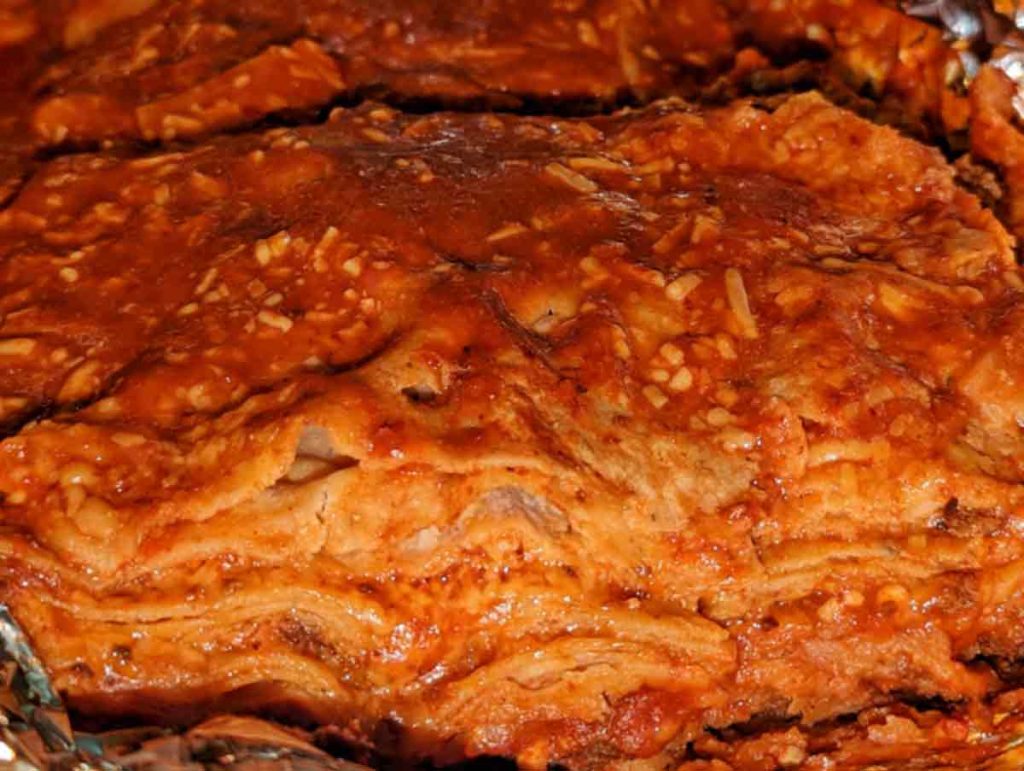
A New Mexican red chile sauce is essentially the mother sauce of New Mexican cuisine, comparable to the béchamel sauce in French food. To make it, just pull some chile off the bottom of the ristra, take out the seeds, and blend it with water and spices. After that, boil it for a short time to reduce it to the consistency you desire in a sauce. Check out our guide to red chile sauce here for more detailed information. We also have plenty of different ideas to cook with both red and green chile in our recipes section!
When are Ristras Available?
Fresh chile ristras typically are available to buy around Labor Day, which coincides with the Hatch Chile Festival. Red chile used in tying ristras is just the fully mature version of green chile in New Mexico. It takes about an extra month of growing for red chile to be ready to tie into ristras. In case you want to make your own, sacks of fresh Hatch red chile typically are available about a week after Labor Day. Read on to learn how to make one yourself!
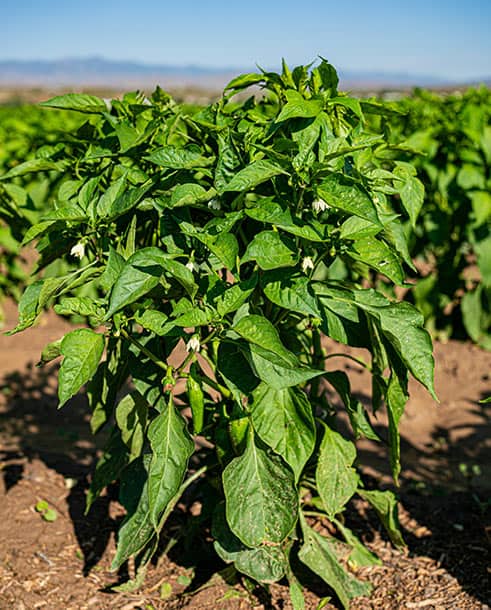
How to Make A Chile Ristra
Tying or sewing a ristra is typically cheaper than buying one, and also a fun activity to try with friends and family! The two main methods of making a ristra are tying the stems of chile to twine, or sewing a thread through the stems.
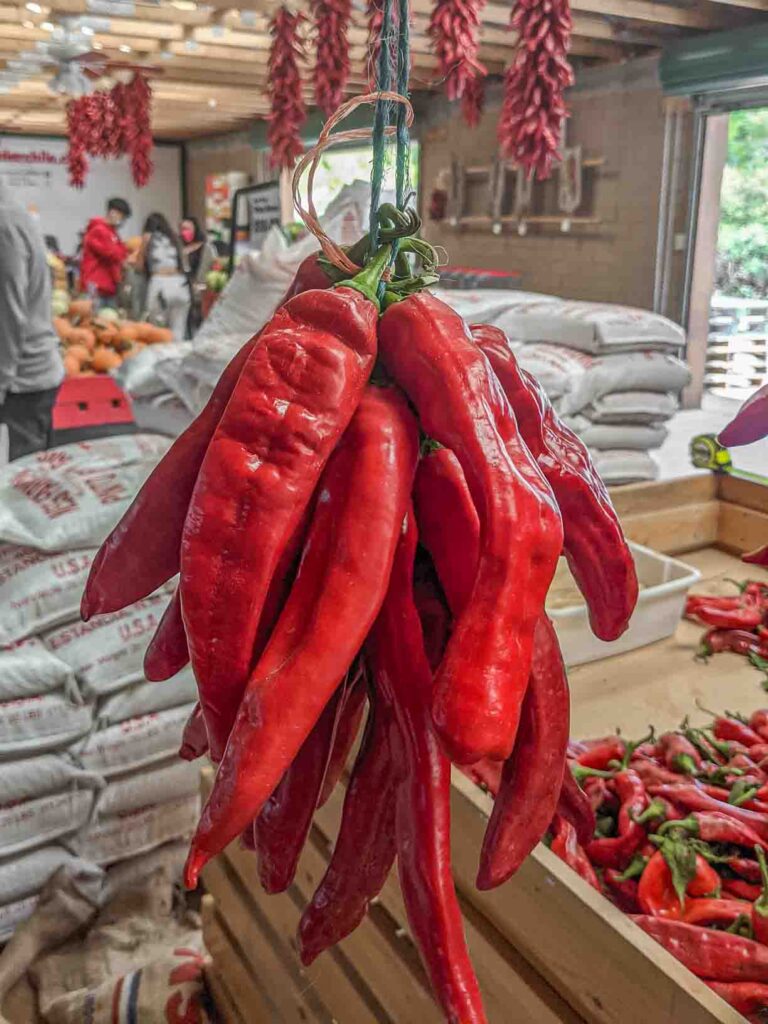
Tying a ristra
If you are used to tying knots, the tying method is probably best for you, as it tends to be more durable than sewing. Make a loop that is slightly shorter than you want your chile ristra to be. You want to wrap each chile individually, then also tie a group of 3 or 4 chiles together with a final knot that is very tight. This way you have multiple loops around every chile, and also have them connected to each other, preventing excessive movement of individual chile peppers. Then you keep looping and stacking chile on top, until you get to about 6 inches from your top loop. Try to pick chile that will make a good ristra shape. You will intuitively see how to do this after you get a ristra to about 6 inches long. From there, I recommend putting shredded corn husks on the top, then hanging it where you want. Read on to learn how to shred corn husks to top your ristra!
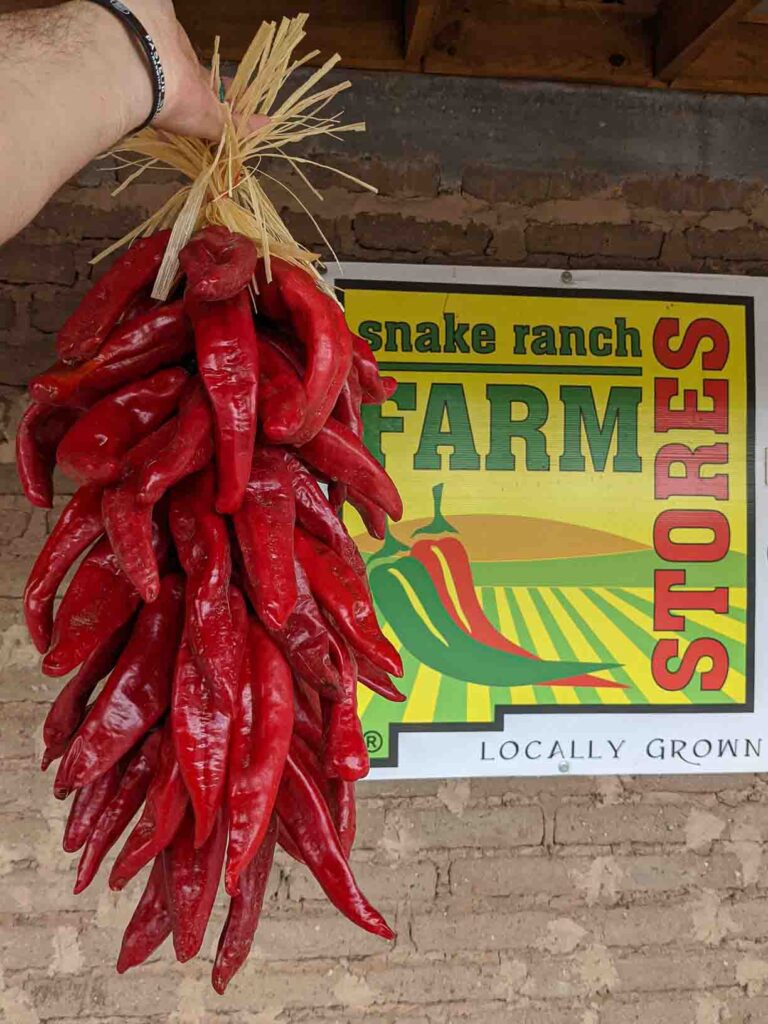
Sewing a ristra
If you sew, you will be putting a hole in the middle of the chile, which can make it more fragile once it dries. That being said, both methods will make a beautiful ristra that lasts a while, provided you hang your ristra properly. When you sew, just run the needle through each chile stem as close to the middle as you can. Using a small needle is a good idea, so the hole in the stem is as small as possible. From there, you just add chile after chile, but try to keep the shape even, it is much better to adjust as you go than try to adjust it after you are done. This part is easy, you will be familiar with how to do it after you have a few layers. Just the same as trying a ristra, you want to have a loop at the top to hang it.
Topping your Ristra
Topping the ristra with shredded corn husks is the typical fashion for finishing a ristra in New Mexico. Soak the dried corn husks for a few minutes before shredding them with a fork or some other tool that you have on hand for this. Many farmers just use a small piece of wood with finishing nails hammered through it as a makeshift shredder! Just tie twine around shredded corn husks with a loose knot, then pull it down over the ristra’s hanging loop. Finally, tighten the knot a little more and you have a finished ristra!
Keeping your ristra nice
Be sure to check out our guide on where to hang a chile ristra, which contains a lot of information about an ideal place to hang a ristra. It is important to balance aesthetics with damage potential of a hanging location, as ristras are pretty fragile decorations.
How to treat a chile ristra
At Farmers Chile Market, we are a simple food store, and do not treat ristras or sell treated ristras. There are many guides to treat ristras, and it can be done with lacquer, shellac, acrylic spray-paint, or even melted beeswax! Just be sure the ristra is completely dry before treating it, as residual wetness inside of the chile will mold and cause the ristra to decay if it is not fully dry before treatment. Whatever method you choose, be sure to do it in a well ventilated area. Gently lift the individual chile peppers in the ristras up to expose the backside to coat the whole chile, and be sure to use gloves to keep your hands clean.
Varieties of ristras
At Farmers Chile Market, we have many different varieties of ristras for sale once fresh red chile is in season. Every chile ristra we well is made with red chile grown in the sunny Hatch Valley, the Chile Capital of the World! Most of them are made with hot Sandia chile, but we also carry multi-color ristras, pequin ristras, special shapes, and also many different sizes. In general, our ristras are bigger than we say they are. We want you to get a good value. Ristras are quite fragile. If any chile falls off, there will still be plenty of others still hanging. Take the chile that falls off and cook something with it, they are delicious!
We strive to be the best place to get chile ristras in Albuquerque. As of the 2024 chile season, we have been selling them for more than 50 years. If you are from Albuquerque, you can bet that your grandparents got a ristra at some point from Farmers Market on Eubank and Snowheights, or one of our many other locations through the years. Our name is slightly different now, and our business is seasonal, but you can be assured that we have plenty of beautiful and tasty chile ristras to buy. Buying a ristra from us supports local New Mexican small businesses and farmers
Traditional Large Sandia Chile Ristras
Sandia chile is the typical hot chile variety in New Mexico. If you get a red chile sauce in New Mexico, odds are it was made with this type of chile. It dries very well, while not being too small or fragile. The heat it carries is just right for most New Mexicans. We carry these in many sizes from 1-ft to 5-ft, and also carry wreaths which have 3 and 4 feet worth of chile inside them.
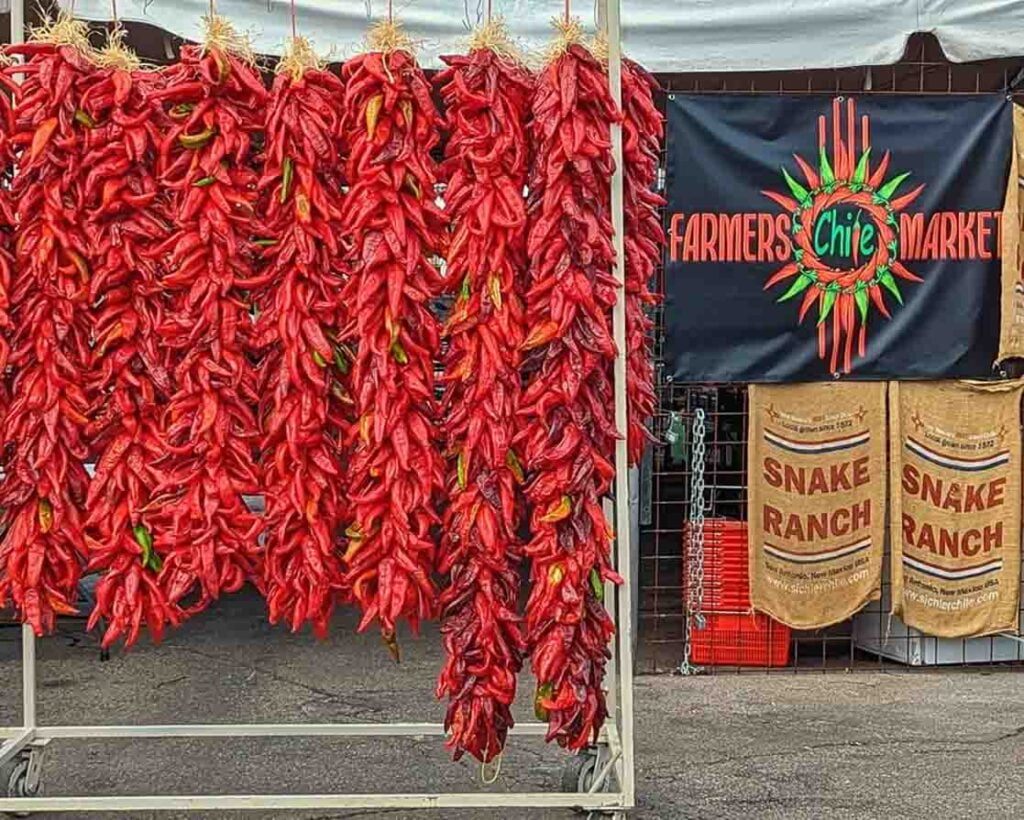
Pequin Chile Ristras
In New Mexico, we typically call this chile variety chile pequin, but it is also called chile de arbol in Mexico. This chile is much smaller and quite a bit spicier than Sandia chile, measuring in around 30,000 Scoville, or over five times hotter than Sandia chile. This chile has a strong, long and thin stem, which makes it ideal for making into special shapes. By mid September, we carry many types of pequin chile ristras for sale, including 3 inch, 6 inch, 12 inch, and 2 ft. We also often carry many special shapes, such as wreaths, crosses, and hearts. Pequin wreaths are particularly popular around Christmas!
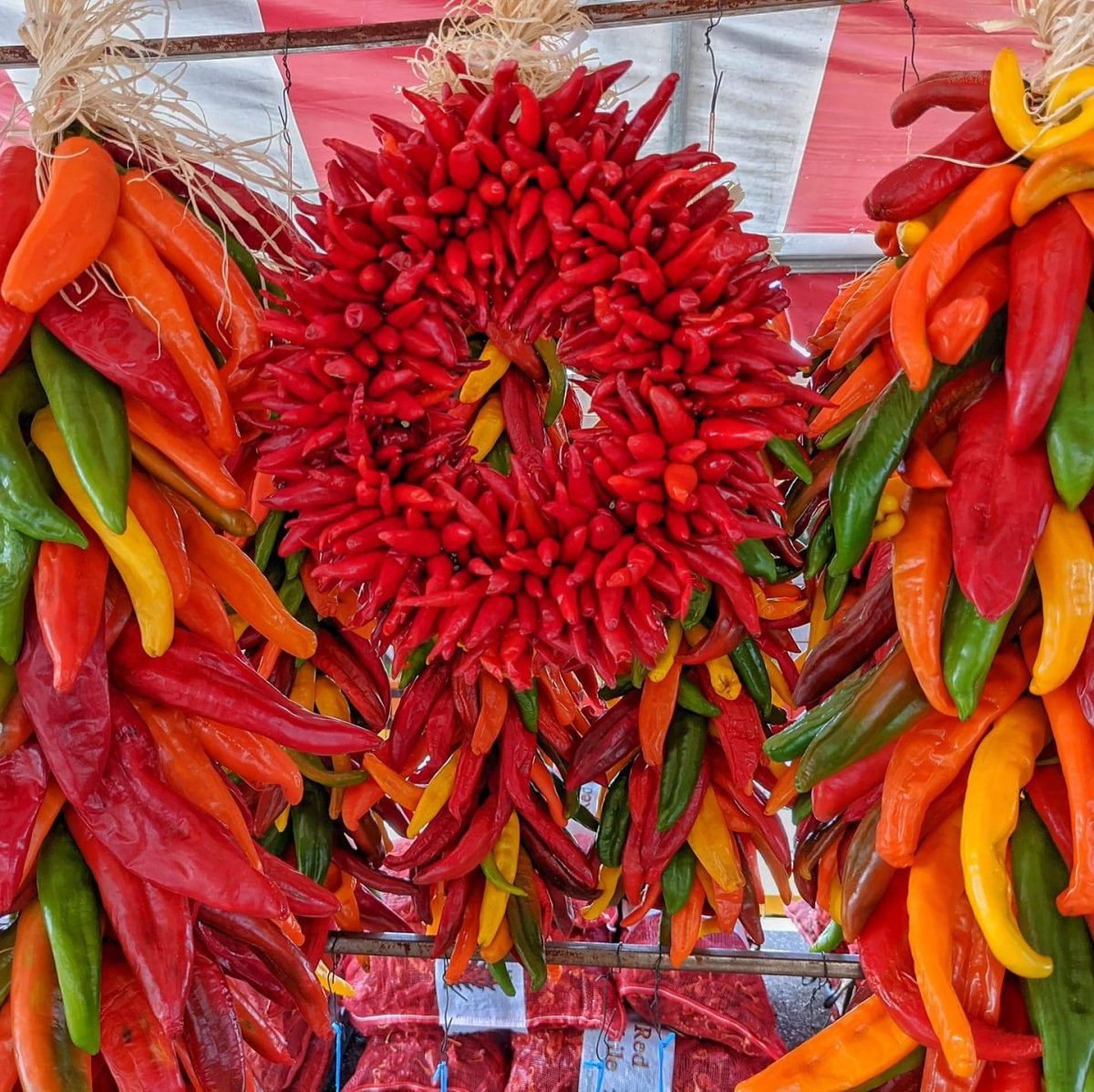
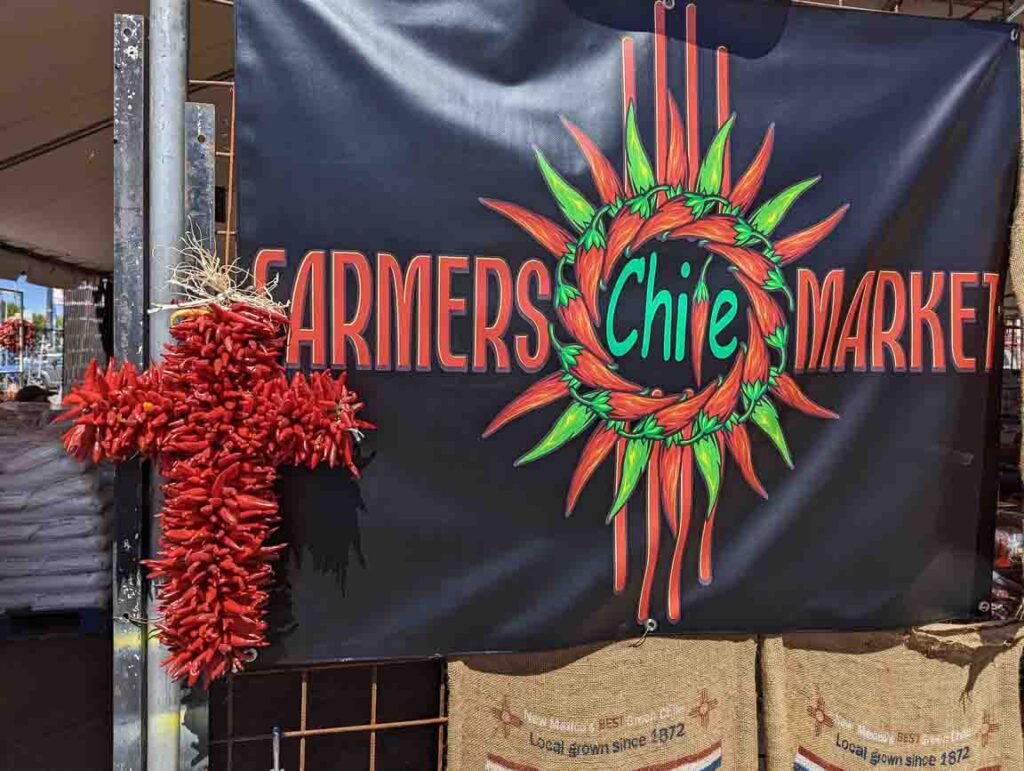
Red Chile Wreaths
We also carry a large variety of different chili ristra wreaths. The large chile wreaths are made with sandia chile, and are a hot variety of chile. The small chile wreaths are made with chile de arbol, also known as chile pequin in New Mexico. These small chile peppers have a very high amount of heat. In September, we typically have multiple sizes of both large Sandia chile wreaths and smaller pequin chile wreaths. Keep in mind that the amount of chile used in wreaths is a lot more than a typical ristra, and the cost to buy them is also higher. That being said, few things look better decorating a doorway than a dried red chile wreath!
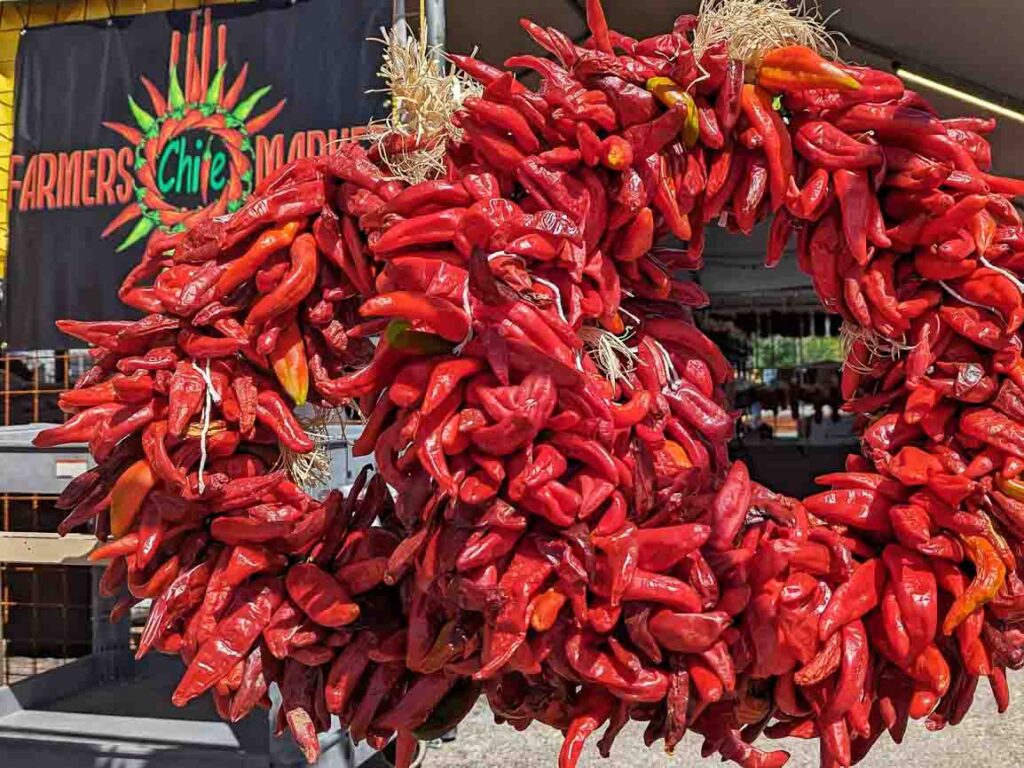
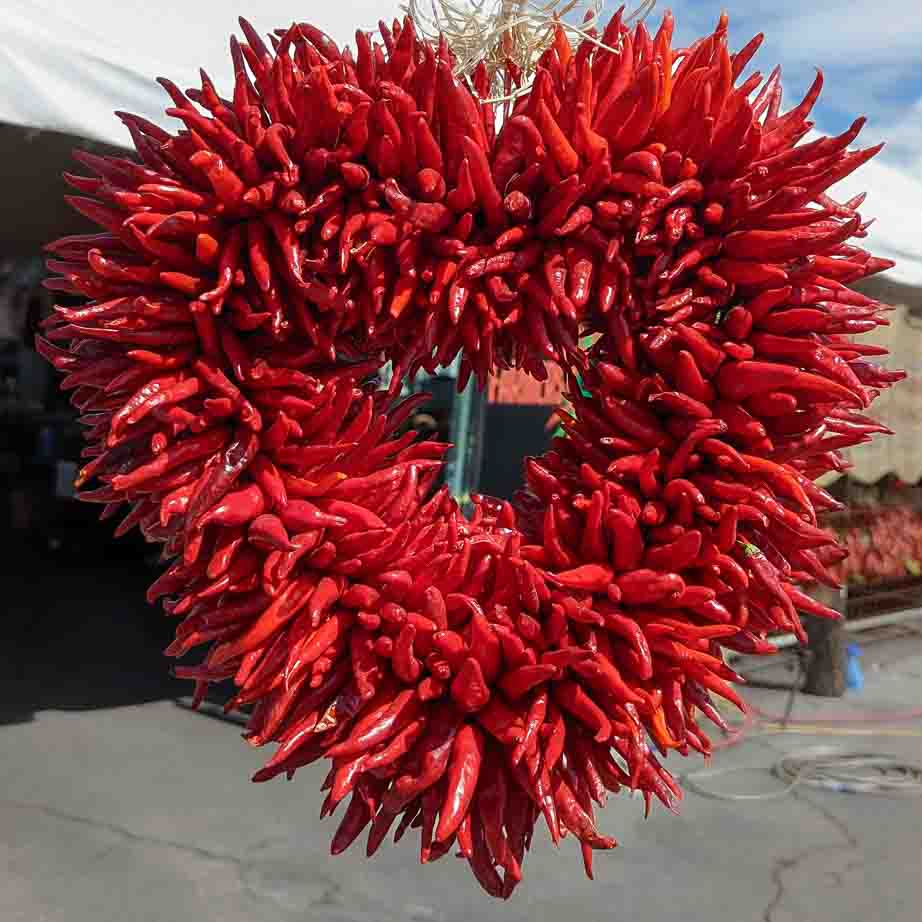
More information about chile ristras
The National Parks Service wrote a great article, so check it out if you want to read more about ristras. I am hoping to teach classes about tying ristras at my chile stand at some point, maybe chile season 2024. I’m one of the busiest chile roasters in New Mexico, so it is hard to pull myself away from other operations to teach a class as of now.
In our blog, we have plenty of information and recipes available to show you how to use chile from a ristra, including a guide on where to hang it. I keep it updated with new content throughout the year, but slow down a lot during chile season in order to properly manage my chile roaster at 2010 Eubank Blvd NE in Albuquerque. One thing you can be sure of, is that I will keep researching and staying up to date on anything chile related in New Mexico. Check out my post to learn about me, and how I learned about chile, food, fermentation, ristra tying, and much more. I hope you can check back for new information about cooking, ristras, or local New Mexican produce.
Check out our ristra FAQ if you have any questions about ristras.
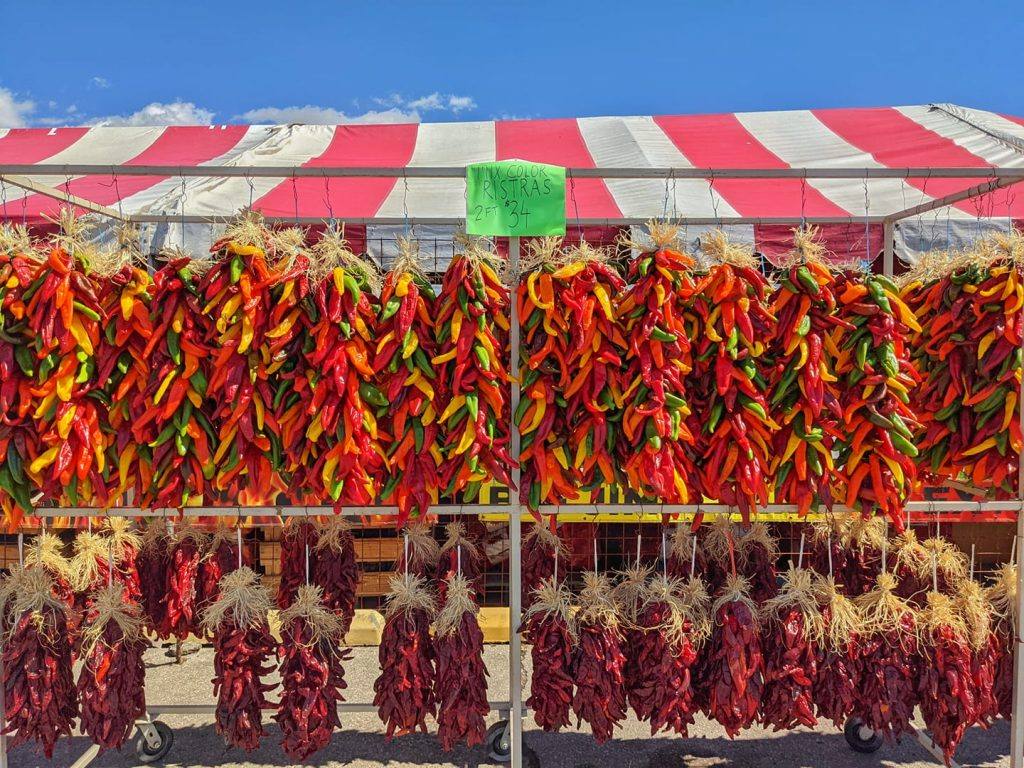
Where to Buy a ristra in Albuquerque
Farmers Chile Market of course. We have many different types of beautiful and edible ristras for sale at great prices. You can find us at 2010 Eubank Blvd NE, Albuquerque, NM 87112 from early chile season in August to the end of December. We have been proud to serve the Northeast Heights and all of Albuquerque. We are just north of I-40 on Eubank, and are quite convenient for people living up on Tramway, or even up in the mountains. If you’re in Albuquerque, we are your solution to the question “where to buy chile ristras near me?” If you are in the greater Albuquerque area, including Corrales and Rio Rancho, be sure to give us a visit por las ristras para la familia!
We keep it local, and buy over 95% of what we sell from local farmers and producers in New Mexico. We get ristras and dried red chile products pretty much exclusively out of the Hatch Valley. Our other produce is often grown even closer, in the Socorro Valley, nearby Lemitar.
During the chile season, we always have plenty of ristras for sale. Generally the best time to get a ristra from us is Friday afternoon or Saturday morning, when we have the most availability. We get ristras in throughout the week, but always load up to prepare for the weekend on Fridays throughout September and October. In November, we have less customers once the green chile season ends. Due to this, we restock less often, but always maintain a large variety through Christmas.
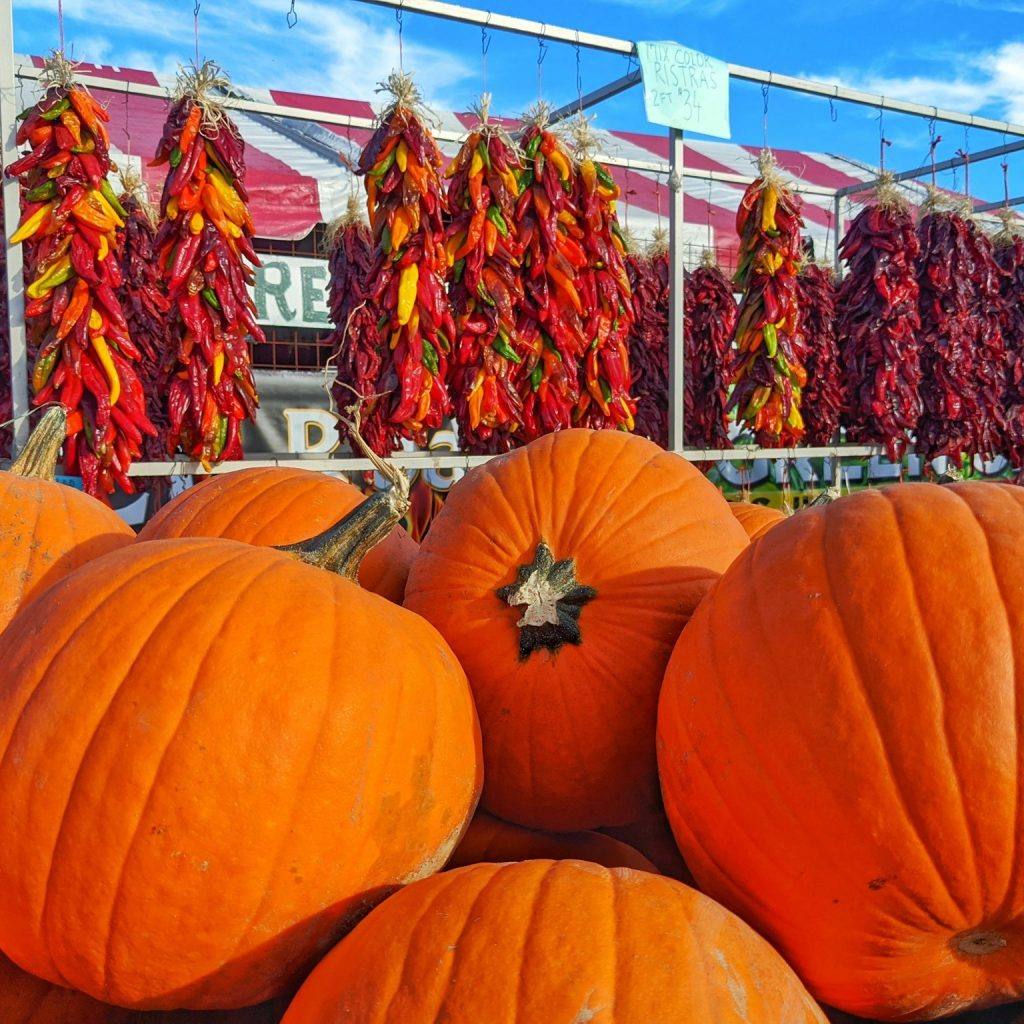
How to buy Chile Ristras Online
On our webshop! We start getting chile ristras in early September every year, and begin shipping them out by mid September, after they have had enough chance to sundry. This way they don’t mold in the box, and also save money on shipping cost due to reduced weight! Even if you can’t visit New Mexico this year, you can get a great southwestern decoration shipped to your door!
Buy a Ristra Online
Check out a few your options to buy a chile ristra or wreath below. We will ship ristras in Mid-September, 2024. Our webshop also includes many other delicious New Mexican delicacies such as green chile, red chile pods, posole, and much more!
Chile Ristra Faq
I get asked a lot of questions from customers buying chile ristras, ranging from “How long do ristras last?’ to “How to take care of a Hatch chile ristra?” This made me think that many people will probably be wondering about it online too. Because of that, I decided to make a quick FAQ with my answers and recommendations on it. If you have questions about the beautiful strings of dried New Mexico chile known as chile ristras, read on adventurer!
In Spanish, ristra means string, but is also used to describe a string of chile peppers.
In English, pretty much the only way people use the term ristra is to talk about chile ristras, with a very small minority also using the term to talk about garlic bulb ristras!
Originally, chile ristras were made only as a way to preserve chile, and keep it available as a food source in the cold winter. In modern times, food is less scarce, and most people make them as a decoration primarily. They still are a great source of food however, and we highly recommend cooking with chile from an older ristra when you get a new one!
The answer depends on many factors. An untreated ristra kept in good conditions will still look good after two years. A treated one might last 5 years or more. If it is kept in unfavorable conditions, it will break down sooner. One bad storm can destroy a ristra.
A ristra should be kept hanging, away from wind that will cause it to hit hard surfaces. The sun won’t damage sandia chiles as much as pequin, but will cause fading over time as well. If you want a ristra to last as long as possible, keep it in a cool, dry, and dark place without wind. If you want to display it outside, keep it in a partial sunlight area that is not windy.
Although a small amount of water getting on a ristra probably won’t be a problem in a dry state like New Mexico, it should be avoided. Ristras which get wet can become a breeding ground for mold, which will eat the ristra from the inside out!
The traditional New Mexican ristras are made with sandia chile, which is typically considered a “hot” chile. Pequin ristras however are much more spicy. If you want to cook with them, be very careful with the amount you use.
Every ristra that we sell at Farmers Chile Market is untreated, and therefore edible. Even if you have the chile after 2 or 3 years, it will still be delicious.
Red chile sauces are incredibly easy to make. All one needs to do is take out the stem and seeds from chile on the ristra, blend it up for about 10 minutes with some garlic powder and onion powder, then boil it with a chicken or vegetable stock. Altogether, the whole process takes less than an hour, and you can make a red chile sauce which will last a year or more in the freezer.
Take the chile from the bottom of the ristra, then tuck the string up into the remaining chile. This lets you keep the ristra beautiful while also able to eat the delicious red chile from your ristra.
It is a process of tying chile stems together with twine. Check our chile ristras page for a more detailed guide on making a ristra!
Most ristras in New Mexico are made with sandia chile, though many special shaped ristras are made with chile pequin, also known as chile de arbol as well.
In case the ristra is using a large Sandia chile pepper, it will be around 6,000 SHU. Hot, but not super hot. If it is using small chile pequin, then it will be around 30,000, which is very hot, and will be too spicy for most people, even in New Mexico!
If you want to travel with a ristra, it is best to get one that is not totally fresh, but also not completely dry. This is because fresh ristras might rot, and dry ristras are more prone to breakage. Second, it is best not to lay it down for too long, as the ristra may become deformed. If you can rotate it, this problem will be less serious. If you are taking it on an airplane, I recommend wrapping it in something breathable and soft, so it can’t be jostled around too easily, and still has some ability for airflow. When driving, I recommend hanging it on a hook, provided it does not bang against the windows. If you don’t have hooks, I recommend just laying it flat as straight as possible, and gently turn it daily to prevent it becoming deformed.
All our ristras come from the sunny Hatch Valley, in southern New Mexico.
Farmers Chile Market at 2010 Eubank Blvd NE 87112. We get fresh chile ristras in around the start of September every year, and continue selling ristras until Christmas every year.
Most green chile varieties turn to a yellowish brown color when they dry. In some multicolored ristras, this is not bad, as it provides more color variety. That being said, it looks unappealing compared to red chile ristras.
Generally ristras are available once Hatch green chile has had a time to mature and turn red. This typically happens about a month after chile season begins. New Mexico becomes usually awash in fresh ristras around the start of September.
Fresh ristras are a seasonal item in New Mexico, with the majority being tied in the months of September and October. Because they are sun dried, they are shelf stable at room temperature, and can be obtained at any time, but they won’t be bright and fresh like the ones you can get during the chile season.
Hang them in a place which isn’t too windy, so the chile doesn’t get damaged. Partial sunlight is best to avoid fading, but red chile ristras kept in the sun will still continue looking good for a long time. We also have a more detailed answer in our post Where to hang a chile ristra?
You can eat Farmers Chile Market ristras once they are dry as all of our ristras are untreated! Be sure to bring your chile sauce to a low boil for a short time to ensure food safety. Some sellers will treat the ristras with inedible materials to make them look fresh for longer, rendering them inedible.
Typically ristras are made with large sandia chile pods, a hot New Mexico chile which dries very well. If the chile is small, it is likely chile pequin, also known as chile de arbol in old Mexico.
If they are stored well, with cool temperatures and low humidity, chile pods keep a good flavor for a few years.
We will begin shipping chile ristras in mid-September this 2024 chile season. Click to jump to a list different options for chile ristras for sale!
Once the chile has had enough time to ripen to red, chile ristras will arrive within days. When fresh chile ristras come in depends a lot on the chile season, as some years chie matures faster than others. That being said, they are typically ready by early September.
Chile de ristra flavor depends on what kind of chile the ristra is made of. A typical large pepper Hatch chile ristra is made with Sandia chile, which is a hot variety. The types of ristras using smaller chile are typically made with chile de arbol, also commonly called chile pequin in New Mexico. This chile is much hotter, and should be used with caution, as the spice can easily overwhelm most people.
We have a really wide variety of ristras, ranging from a few inches to 5 feet long. We also sell different shapes, colors, and chile varieties too! Check out our list of ristras above for more information!
